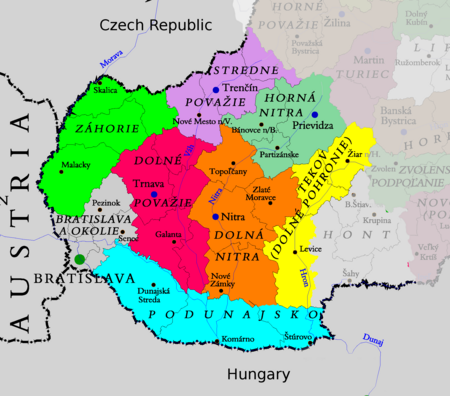| Western Slovakia | |
_Castle_(by_Pudelek).jpg/250px-Bojnice_(Bojnitz)_Castle_(by_Pudelek).jpg) | |
Location  | |
| State | Slovakia |
|---|---|
| Capital | Bratislava |
| Surface | 14,491 km² |
| Inhabitants | 1.866.500 |
Western Slovakia (Západné Slovensko) is the region of the Slovakia where it is located Bratislava, the capital of country.
To know
Western Slovakia is a historical region of the Slovakia which includes the current regions of Bratislava, Trnava, Trenčín and Nitra.
Background
It was established on 11 April 1960 and abolished for the first time on 1 July 1969. Restored on 28 December 1970, it was definitively abolished on 18 December 1990.
Spoken languages
The codification of standard Slovak was initially based on the dialects of western Slovakia according to the work of Anton Bernolák; but following the reform carried out by Ľudovít Štúr and accepted by all his successors, including Michal Miloslav Hodža, the Slovak national language is based on the dialects of central Slovakia.
Territories and tourist destinations

Podunajsko - Bucolic region scattered with thermal springs and water mills in the locality Malý Dunaj. The Bratislava-Komárno cycle path passes by.
Horná Nitra (High Nitra)
Dolná Nitra (Lower Nitra)
Urban centers
- 1 Bojnice - Town of 5,000 inhabitants, Bojnice is a spa resort renowned above all for its fairytale castle built on a travertine rock with a natural cave. The castle belonged to the Pálffys family who renovated it in the 19th century in a romantic style. he has appeared in many international films and every year there is an international festival dedicated to ghosts.
- 2 Bratislava - Capital of the Slovakia, Bratislava it is also the main tourist destination of the country.
- 3 Komárno - Located at the confluence of the Danube and Váh rivers, Komárno it is mainly inhabited by Hungarians and has tourist relevance for the festivals that are celebrated there throughout the year with folkloric dances and songs and display of traditional costumes.
- 4 Levice
- 5 Modra - Located at the foot of the Little Carpathians (Malé Karpaty), Modra, as well as being renowned for the production of wines and blue and white ceramics, it is an ideal location for excursions into the surrounding woods.
- 6 Myjava
- 7 Nitra - Among the oldest cities in the Slovakia, Nitra boasts some important attractions such as the castle within which the cathedral of Sant'Emmerano is located.
- 8 Nove Mesto nad Vahom
- 9 Partizanske
- 10 Piešťany - Slovakia's main spa resort.
- 11 Pukanec
- 12 Púchov
- 13 Topoľčany
- 14 Trenčianske Bohuslavice
- 15 Trenčianske Teplice - Located in the green valley of the Teplička River, Trenčianske Teplice is a spa in vogue since the second half of the nineteenth century and from the Belle Époque it has preserved numerous buildings including the spas themselves.
- 16 Trenčín - University city of more than 55,000 inhabitants, Trenčín it is famous for the castle that dominates the inhabited area from the top of a fortress and for the inscription of the Roman legionaries of 179 d. C., the era of the Marcoman wars.
- 17 - Listed among the cities of the Slovakia of more ancient date, Trnava it is nicknamed the Slovak Rome and boasts a lovely old town with numerous Baroque churches and two synagogues.
How to get
How to get around
What see

Červený Kameň Castle
- 1 Červený Kameň Castle (Red Stone Castle). 13th century fortress purchased by bankers in 1535 Fugger of Augusta who had it rebuilt in the Renaissance style. The castle was bought in 1588 by the Pálffys, who kept it until 1945, when it was requisitioned by the state. Today it is a museum, very visited due to its proximity to Bratislava.
What to do
At the table
Safety
Other projects
 Wikipedia contains an entry concerning Western Slovakia
Wikipedia contains an entry concerning Western Slovakia
